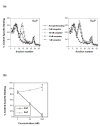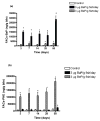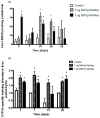Reduced cytochrome P4501A activity and recovery from oxidative stress during subchronic benzo[a]pyrene and benzo[e]pyrene treatment of rainbow trout
- PMID: 21550360
- PMCID: PMC3124960
- DOI: 10.1016/j.taap.2011.04.015
Reduced cytochrome P4501A activity and recovery from oxidative stress during subchronic benzo[a]pyrene and benzo[e]pyrene treatment of rainbow trout
Abstract
This study assessed the role of aryl hydrocarbon receptor (AHR) affinity, and cytochrome P4501A (CYP1A) protein and activity in polyaromatic hydrocarbon (PAH)-induced oxidative stress. In the 1-100nM concentration range benzo[a]pyrene (BaP) but not benzo[e]pyrene (BeP) competitively displaced 2nM [(3)H]2, 3, 7, 8-tetrachloro-dibenzo-p-dioxin from rainbow trout AHR2α. Based on appearance of fluorescent aromatic compounds in bile over 3, 7, 14, 28 or 50days of feeding 3μg of BaP or BeP/g fish/day, rainbow trout liver readily excreted these polyaromatic hydrocarbons (PAHs) and their metabolites at near steady state rates. CYP1A proteins catalyzed more than 98% of ethoxyresorufin-O-deethylase (EROD) activity in rainbow trout hepatic microsomes. EROD activity of hepatic microsomes initially increased and then decreased to control activities after 50days of feeding both PAHs. Immunohistochemistry of liver confirmed CYP1A protein increased in fish fed both PAHs after 3days and remained elevated for up to 28days. Neither BaP nor BeP increased hepatic DNA adduct concentrations at any time up to 50days of feeding these PAHs. Comet assays of blood cells demonstrated marked DNA damage after 14days of feeding both PAHs that was not significant after 50days. There was a strong positive correlation between hepatic EROD activity and DNA damage in blood cells over time for both PAHs. Neither CYP1A protein nor 3-nitrotyrosine (a biomarker for oxidative stress) immunostaining in trunk kidney were significantly altered by BaP or BeP after 3, 7, 14, or 28days. There was no clear association between AHR2α affinity and BaP and BeP-induced oxidative stress.
Copyright © 2011 Elsevier Inc. All rights reserved.
Conflict of interest statement
Conflict of Interest Statement
No conflicts of interest exist for the authors of this paper.
Figures





Similar articles
-
Cytochrome P4501A induction in rainbow trout gills and liver following exposure to waterborne indigo, benzo[a]pyrene and 3,3',4,4',5-pentachlorobiphenyl.Aquat Toxicol. 2006 Sep 12;79(3):226-32. doi: 10.1016/j.aquatox.2006.06.006. Epub 2006 Jul 26. Aquat Toxicol. 2006. PMID: 16872689
-
In vivo and in vitro inhibition of CYP1A-dependent activity in Fundulus heteroclitus by the polynuclear aromatic hydrocarbon fluoranthene.Toxicol Appl Pharmacol. 2001 Dec 15;177(3):264-71. doi: 10.1006/taap.2001.9296. Toxicol Appl Pharmacol. 2001. PMID: 11749126
-
Surface marker-defined head kidney granulocytes and B lymphocytes of rainbow trout express benzo[a]pyrene-inducible cytochrome P4501A protein.Toxicol Sci. 2008 May;103(1):86-96. doi: 10.1093/toxsci/kfn024. Epub 2008 Feb 14. Toxicol Sci. 2008. PMID: 18281257
-
Tissue-specific metabolism of benzo[a]pyrene in rainbow trout (Oncorhynchus mykiss): a comparison between the liver and immune organs.Drug Metab Dispos. 2014 Jan;42(1):111-8. doi: 10.1124/dmd.113.053777. Epub 2013 Oct 21. Drug Metab Dispos. 2014. PMID: 24144719
-
Cell-specific CYP1A expression and benzo[a]pyrene adduct formation in gills of rainbow trout (Oncorhynchus mykiss) following CYP1A induction in the laboratory and in the field.Environ Toxicol Chem. 2004 Apr;23(4):874-82. doi: 10.1897/03-211. Environ Toxicol Chem. 2004. PMID: 15095882
Cited by
-
Responses of cytochrome P450, GST, and MXR in the mollusk Corbicula fluminea to the exposure to hospital wastewater effluents.Environ Sci Pollut Res Int. 2015 Jul;22(14):11033-46. doi: 10.1007/s11356-015-4309-x. Epub 2015 Mar 21. Environ Sci Pollut Res Int. 2015. PMID: 25791265
-
Aryl Hydrocarbon Receptor Signaling Is Functional in Immune Cells of Rainbow Trout (Oncorhynchus mykiss).Int J Mol Sci. 2020 Aug 31;21(17):6323. doi: 10.3390/ijms21176323. Int J Mol Sci. 2020. PMID: 32878328 Free PMC article.
-
Effects of Environmental Polycyclic Aromatic Hydrocarbons Exposure and Pro-Inflammatory Activity on Type 2 Diabetes Mellitus in US Adults.Open J Air Pollut. 2022 Jun;11(2):29-46. doi: 10.4236/ojap.2022.112003. Epub 2022 Jun 24. Open J Air Pollut. 2022. PMID: 35844632 Free PMC article.
-
Ras oncogene and Hypoxia-inducible factor-1 alpha (hif-1α) expression in the Amazon fish Colossoma macropomum (Cuvier, 1818) exposed to benzo[a]pyrene.Genet Mol Biol. 2017 Apr-Jun;40(2):491-501. doi: 10.1590/1678-4685-GMB-2016-0066. Epub 2017 May 8. Genet Mol Biol. 2017. PMID: 28486571 Free PMC article.
-
Exposure of adult sea urchin Strongylocentrotus intermedius to stranded heavy fuel oil causes developmental toxicity on larval offspring.PeerJ. 2022 Apr 19;10:e13298. doi: 10.7717/peerj.13298. eCollection 2022. PeerJ. 2022. PMID: 35462773 Free PMC article.
References
-
- Anderson D, Yu TW, Phillips B, Schmezer P. The effects of various antioxidants and other modifying agents on oxygen-radical-generated DNA damage in human lymphocytes in the COMET assay. Mutat Res. 1994;307:261–271. - PubMed
-
- Arkoosh M, Clemons E, Myers M, Casillas E. Suppression of B-cell mediated immunity in juvenile Chinook salmon (Oncorhynchus tshawytsha) after exposure to either a polycyclic aromatic hydrocarbon or to polychlorinated biphenyls. Immunopharm and Immunotox. 1994;16:293–314. - PubMed
-
- Arkoosh M, Clemons E, Huffman P, Kagley A. Increased susceptibility of Juvenile Chinook salmon to Vibriosis after Exposure to Chlorinated and Aromatic Compounds Found in Contaminated Urban Estuaries. J Aquat Anim Hlth. 2001;13:257–268.
-
- Barton HA, Marletta MA. Kinetic and immunochemical studies of a receptor-like protein that binds aromatic hydrocarbons. J Biol Chem. 1988;263:5825–5832. - PubMed
Publication types
MeSH terms
Substances
Grants and funding
LinkOut - more resources
Full Text Sources

